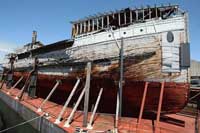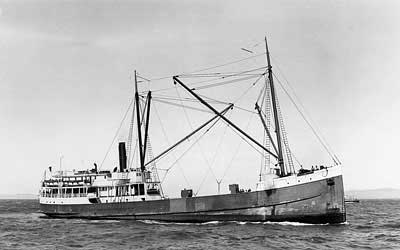
Photo: Lance Iversen / The Chronicle
The National Park Service has decided to dismantle the 96-year-old steam lumber schooner, Wapama, a National Historic Landmark. The ship is the last of of some 225 steam schooners that served the lumber trade and other coastal services along the Pacific Coast.
Lumber schooner Wapama, last of kind, is condemned
The Wapama, which had a long career carrying lumber on the so-called Redwood Coast of California and Oregon, had been a museum ship at the San Francisco Maritime National Historical Park, but old age and dry rot have apparently brought the vessel to the end of the line.
“She held on pretty well for a long time, but then she started to go, like an elderly relative that took a turn for the worse,” said Robyn Jackson, chief of cultural resources for the maritime park. “But now it’s become terminal.”
The 200-foot-long vessel was popular with the public when it first went on display as a museum ship public under auspices of the California State Park system at the Hyde Street pier in 1963.

Wapama, San Francisco Bay Circa 1935
Thanks to Kyle Stubbs for passing the article along.

i know you can’t save them all, but if you consider “ruins” as a memory prompt, then each time such a vessel is scrapped–good as that is from a resource POV–it amounts to a lobotomy. tis a shame
If the NPS had made a real attempt to preserve her, instead of just letting her go…. She’s one of the reasons I stopped volunteering at SFMNHP.
Although built as a passenger vessel and liner for the British emigrant trade and used during most of her career for different purposes, the Euterpe/Star of India still has timber ports that were cut in her stern during an interval when she carried timber. With the demise of Wapama, is there any other vessel left with an association with the timber trade?
I am one of those people who visited Wapama during her heyday as a museum, I think in 1966. I was 13. I never imagined so substantial a museum artifact could just rot away and be broken up. What exists in your childhood seems permanent — I don’t think it’s just me, it’s probably so for everyone. However, recent events in ship preservation (or deterioration) should alert us to the fact that a historic ship, even one that survives into modern times, is not assured continued existence. The role of ship preserver or ship’s “husband” needs to be recognized more. It’s more obvious than ever that without the right attention — not just money but the right maintenance practices — a historic ship will vanish faster than a Cheshire cat.
Pat: The same museums own C.A. Thayer, a lumber schooner, which is perhaps the only other dedicated remainder of the lumber trade with the recent demise of the Wawona in Seattle.
That could be the problem, the two relics in one city, with one being a recently restored showpiece, and the other a rotting bygone. Perhaps the solution is to move the Wapama to another city with lumber connections where she could be loved and preserved, instead of relegating her to a scrap heap.